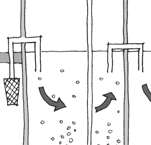Water
Water use, sustainability, and efficiency by choosing quality systems and materials, and providing environmentally friendly solutions.
Aerated and advanced wastewater treatment systems
These systems treat sewage to a higher level than septic tanks. They are typically proprietary systems.
Aerated water treatment systems (AWTS) and advanced sewage treatment systems (ASTS) are secondary treatment systems, that is, they involve both anaerobic and aerobic (with oxygen) treatment to a higher level than a primary treatment system, resulting in effluent that is suitable for garden (excluding fruit and vegetables) and landscape irrigation.
At the highest level of treatment (from ASTS), the treated effluent can be used in non-potable situations such as toilet flushing, vehicle washing and firefighting.
In many areas, a secondary treatment system is the only option permitted.
How an AWTS works
Water flows through a series of chambers or tanks that progressively treat and filter the wastewater | ||
Stage | Type of treatment | Process |
Chamber 1 | Anaerobic | Settlement of solids and anaerobic decomposition |
Chamber 2 | Aeration | Effluent passes through filter to aeration chamber
|
Chamber 3 | Clarification | Effluent passes through second, finer filter to clarification chamber
|
Chamber 4 | Pump | A submersible pump distributes treated effluent to the disposal field |
How an advanced system works
After treating wastewater in a similar process, an advanced treatment system may pass the effluent through a sand filter, a packed bed filter or a textile bed reactor, where effluent trickles through the bed material containing micro-organisms that treat any remaining fine solids before being pumped to the disposal field. There are a number of proprietary systems available. Some of them recirculate effluent several times over the filter/reactor bed, so the final effluent is almost clear and odourless.
Maintenance requirements
Aerated water treatment systems often have a maintenance contract signed at the same time the system is installed. Some manufacturers make it clear that their systems require service and maintenance inspections every six months for the warranty to remain valid.
Inspections should include a check of the condition of filters, pumps and piping and ensuring that the chambers are working properly. Because a pump is a critical component, there is usually an alarm feature (such as a warning light) that comes on when the pump fails. Maintenance should include a check that the alarm is functioning properly.
Inspections will also measure the level of sludge and scum. Aerated systems require sludge to be pumped out every few years, as with septic tanks.
There are often simple maintenance steps that owners can carry out themselves, such as cleaning the outlet filter. The system supplier will provide details.
Updated: 17 April 2019


